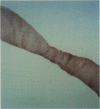Abstract
An enzyme-linked immunosorbent assay (ELISA) has been developed for measuring the in vivo binding of a hexafluorinated 2-nitroimidazole (CCI-103F) in tumour tissue biopsies. The binding of CCI-103F is believed to reflect the presence of hypoxia in tumours. The ELISA provides a sensitive and convenient method of measuring CCI-103F binding which does not require the injection of radioactive reagents. The ELISA is based on reagents prepared from synthetic antigens formed by the reductive activation and binding of CCI-103F to proteins in novel test tube experiments. Calibration of the ELISA involved comparing the ELISA with the radioactivity contained either in protein-CCI-103F adducts formed in vitro with tritiated CCI-103F or in tissues isolated from a tumour-bearing dog which had been injected with tritium-labelled CCI-103F. The two approaches to calibration are compared. The scope and limitation of the ELISA for measuring the binding of CCI-103F is discussed and an example of the application of the ELISA to measuring changes in tumour hypoxia in canine patients undergoing fractionated radiation therapy is presented.
Full text
PDF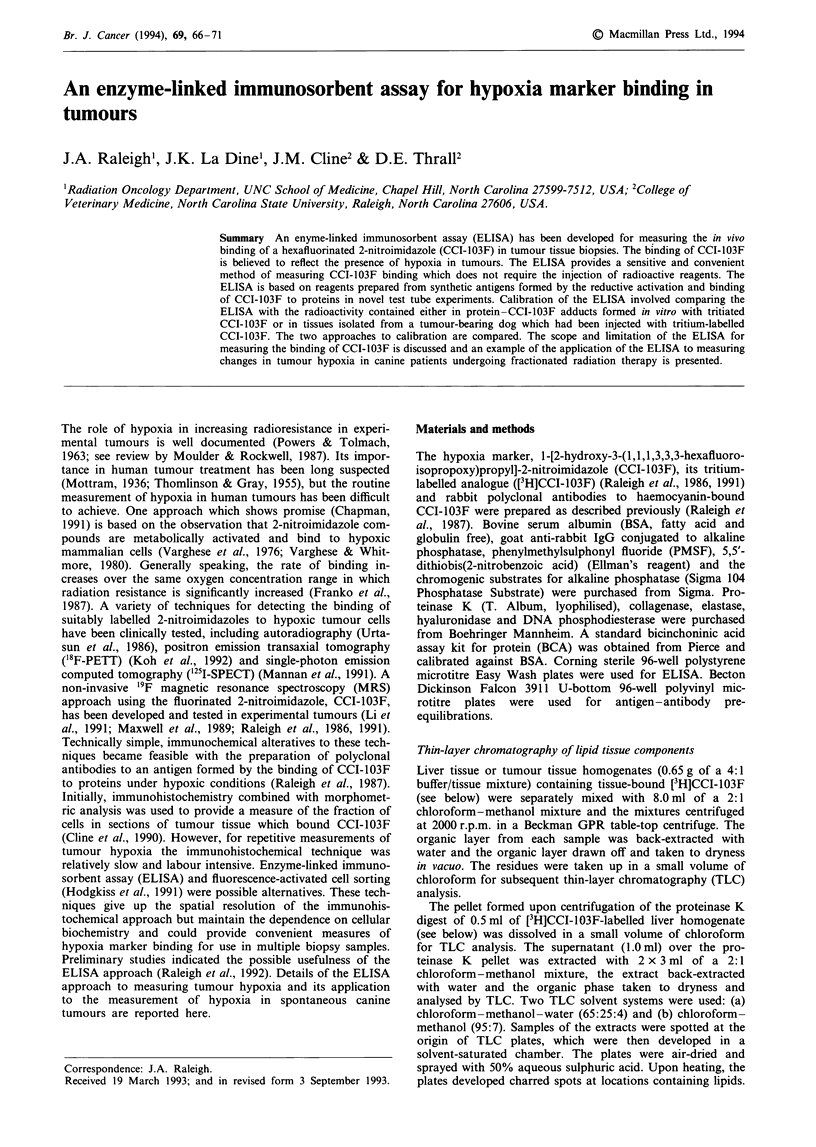
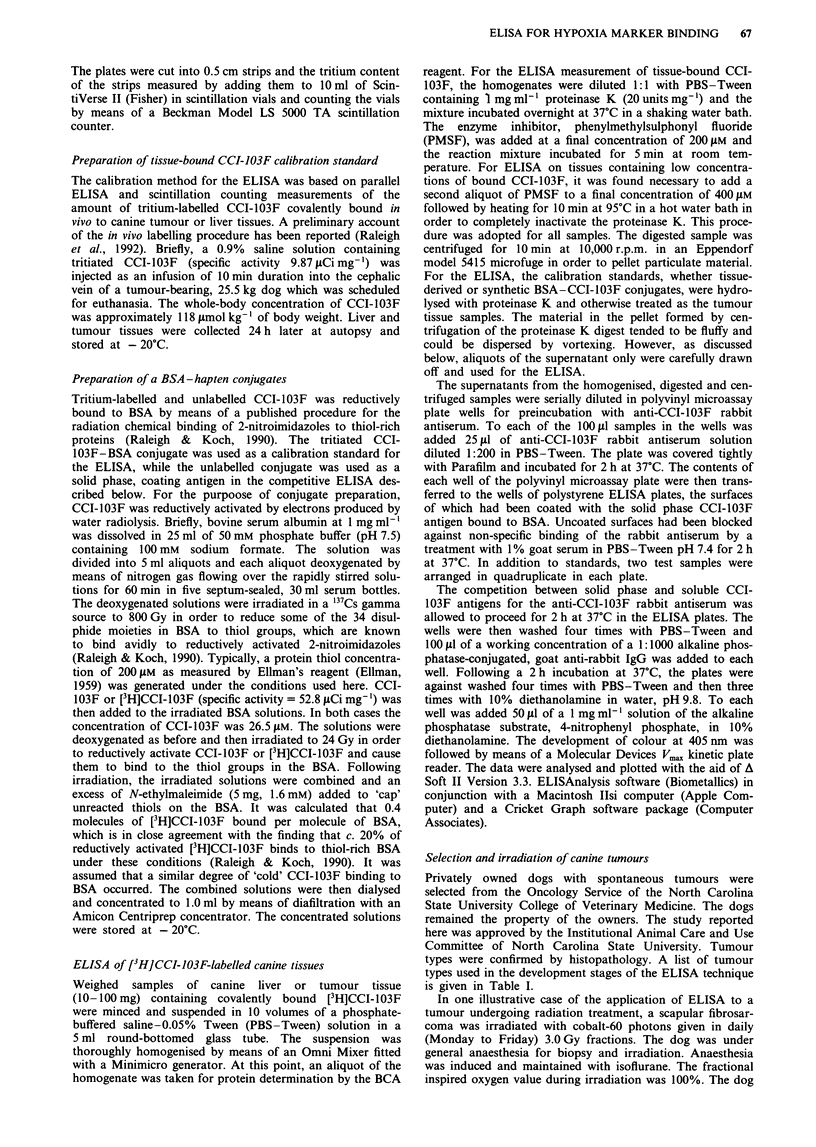
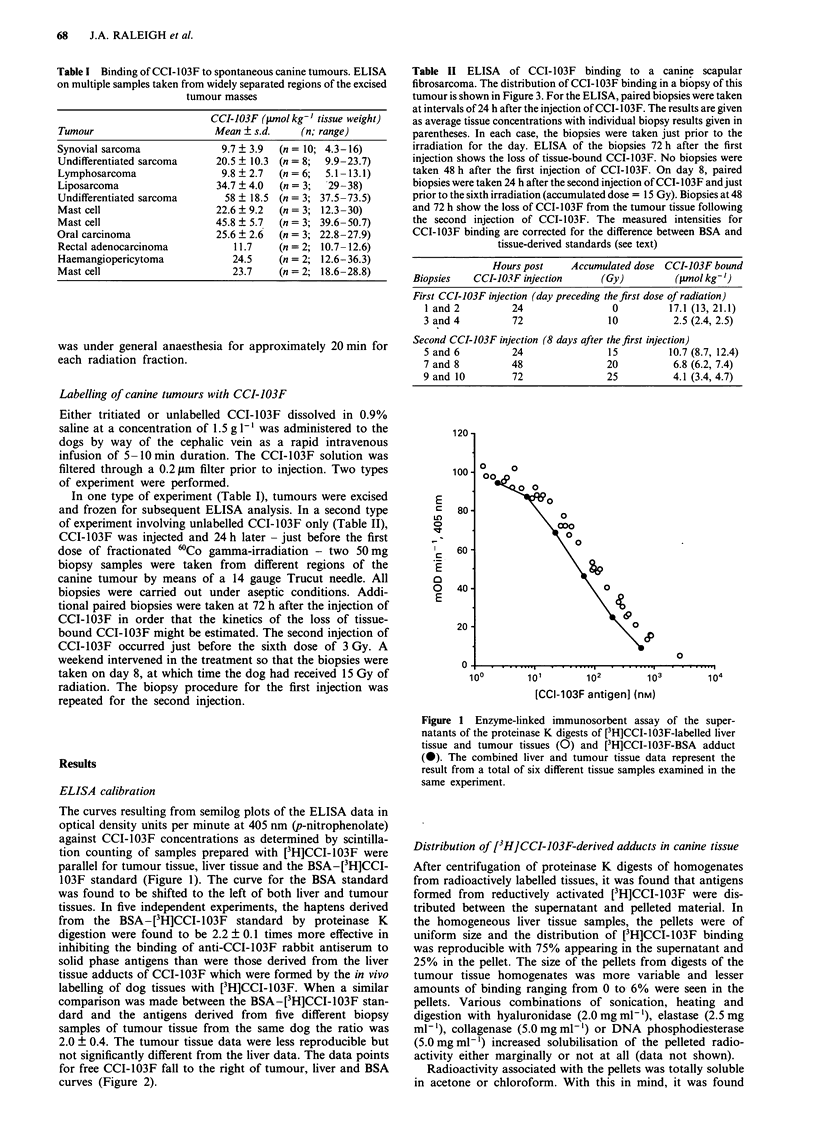
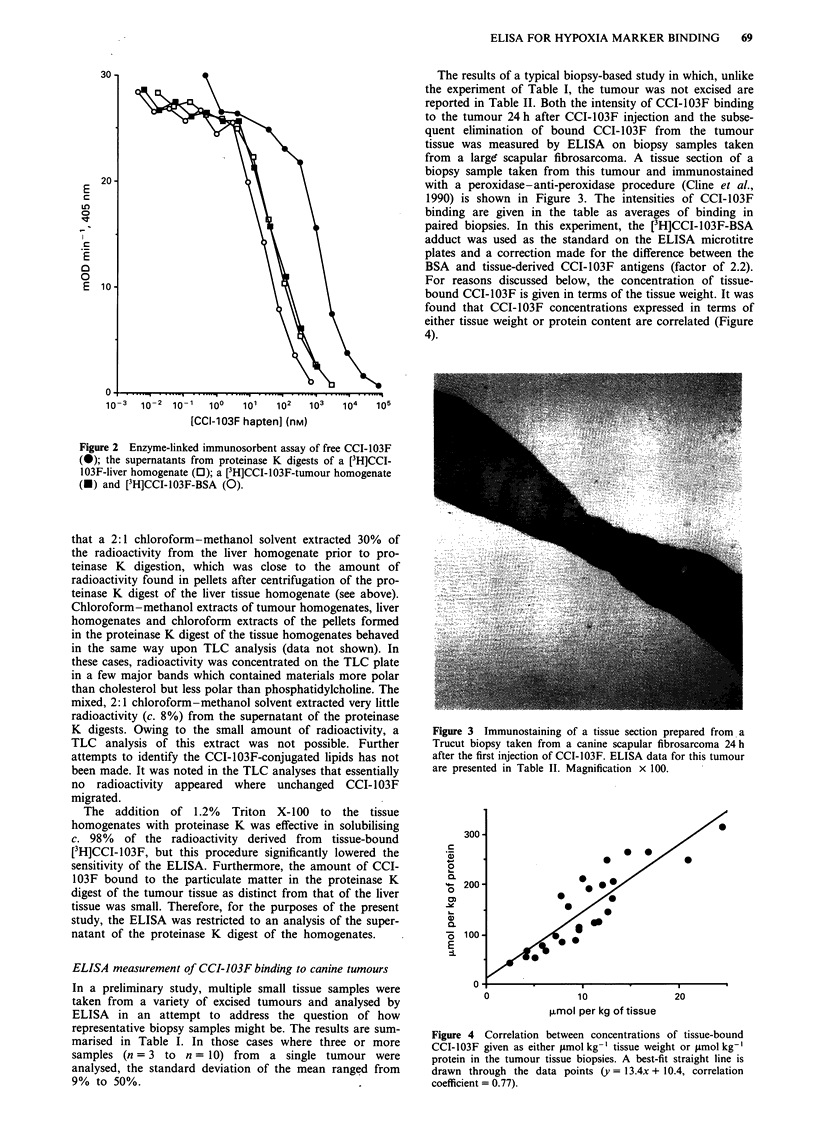
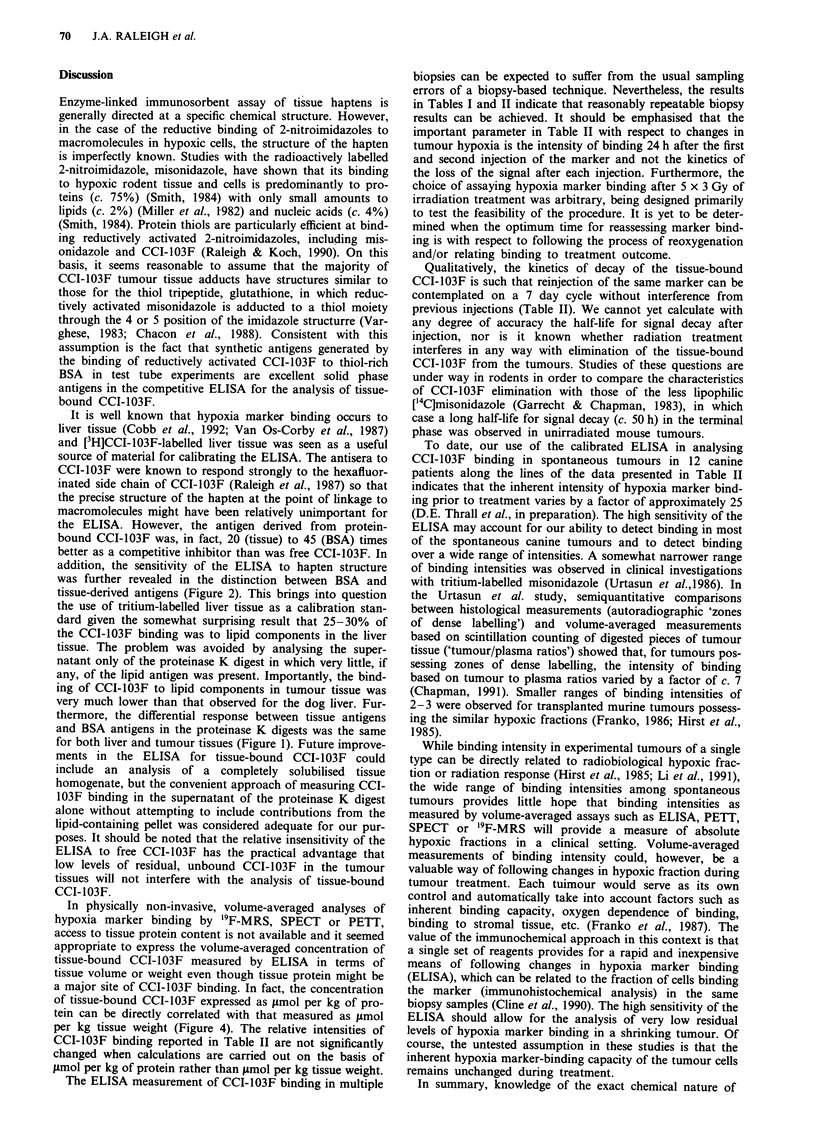
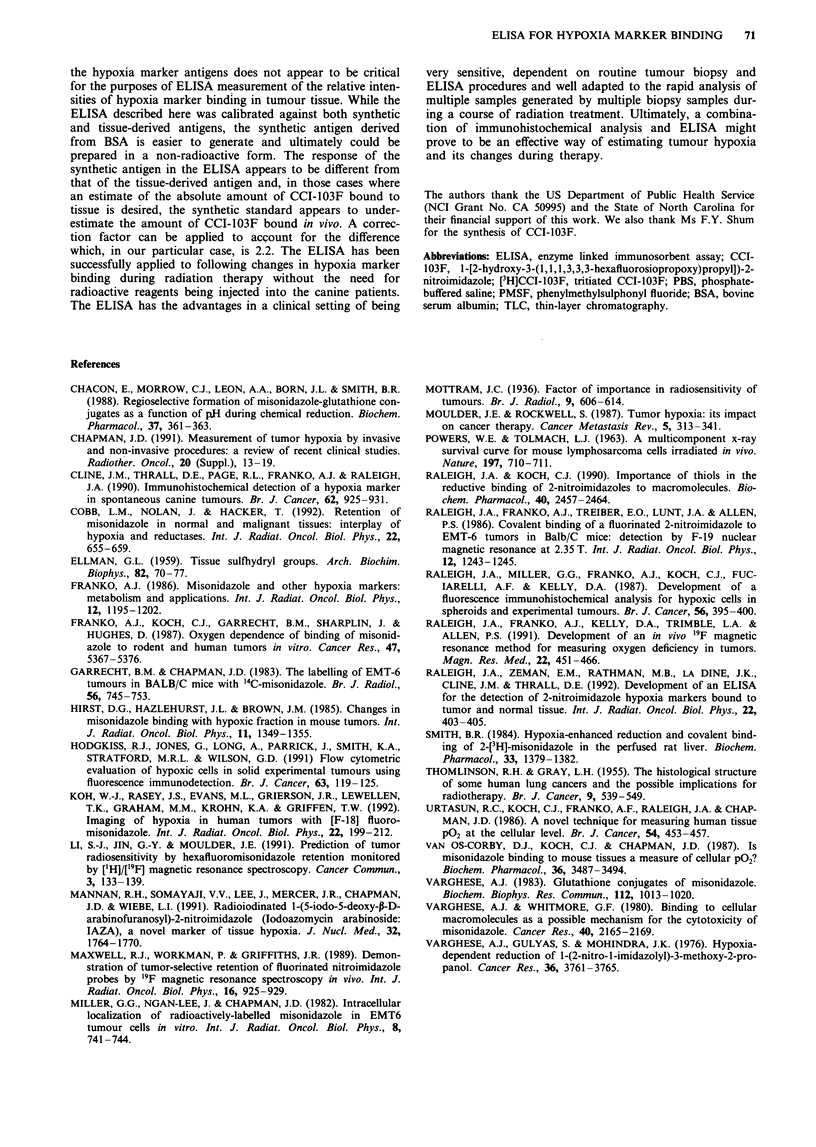
Images in this article
Selected References
These references are in PubMed. This may not be the complete list of references from this article.
- Chacon E., Morrow C. J., Leon A. A., Born J. L., Smith B. R. Regioselective formation of a misonidazole-glutathione conjugate as a function of pH during chemical reduction. Biochem Pharmacol. 1988 Jan 15;37(2):361–363. doi: 10.1016/0006-2952(88)90743-5. [DOI] [PubMed] [Google Scholar]
- Chapman J. D. Measurement of tumor hypoxia by invasive and non-invasive procedures: a review of recent clinical studies. Radiother Oncol. 1991;20 (Suppl 1):13–19. doi: 10.1016/0167-8140(91)90181-f. [DOI] [PubMed] [Google Scholar]
- Cline J. M., Thrall D. E., Page R. L., Franko A. J., Raleigh J. A. Immunohistochemical detection of a hypoxia marker in spontaneous canine tumours. Br J Cancer. 1990 Dec;62(6):925–931. doi: 10.1038/bjc.1990.411. [DOI] [PMC free article] [PubMed] [Google Scholar]
- Cobb L. M., Nolan J., Hacker T. Retention of misonidazole in normal and malignant tissues: interplay of hypoxia and reductases. Int J Radiat Oncol Biol Phys. 1992;22(4):655–659. doi: 10.1016/0360-3016(92)90497-6. [DOI] [PubMed] [Google Scholar]
- ELLMAN G. L. Tissue sulfhydryl groups. Arch Biochem Biophys. 1959 May;82(1):70–77. doi: 10.1016/0003-9861(59)90090-6. [DOI] [PubMed] [Google Scholar]
- Franko A. J., Koch C. J., Garrecht B. M., Sharplin J., Hughes D. Oxygen dependence of binding of misonidazole to rodent and human tumors in vitro. Cancer Res. 1987 Oct 15;47(20):5367–5376. [PubMed] [Google Scholar]
- Franko A. J. Misonidazole and other hypoxia markers: metabolism and applications. Int J Radiat Oncol Biol Phys. 1986 Jul;12(7):1195–1202. doi: 10.1016/0360-3016(86)90257-9. [DOI] [PubMed] [Google Scholar]
- Garrecht B. M., Chapman J. D. The labelling of EMT-6 tumours in BALB/C mice with 14C-misonidazole. Br J Radiol. 1983 Oct;56(670):745–753. doi: 10.1259/0007-1285-56-670-745. [DOI] [PubMed] [Google Scholar]
- Hirst D. G., Hazlehurst J. L., Brown J. M. Changes in misonidazole binding with hypoxic fraction in mouse tumors. Int J Radiat Oncol Biol Phys. 1985 Jul;11(7):1349–1355. doi: 10.1016/0360-3016(85)90251-2. [DOI] [PubMed] [Google Scholar]
- Hodgkiss R. J., Jones G., Long A., Parrick J., Smith K. A., Stratford M. R., Wilson G. D. Flow cytometric evaluation of hypoxic cells in solid experimental tumours using fluorescence immunodetection. Br J Cancer. 1991 Jan;63(1):119–125. doi: 10.1038/bjc.1991.24. [DOI] [PMC free article] [PubMed] [Google Scholar]
- Koh W. J., Rasey J. S., Evans M. L., Grierson J. R., Lewellen T. K., Graham M. M., Krohn K. A., Griffin T. W. Imaging of hypoxia in human tumors with [F-18]fluoromisonidazole. Int J Radiat Oncol Biol Phys. 1992;22(1):199–212. doi: 10.1016/0360-3016(92)91001-4. [DOI] [PubMed] [Google Scholar]
- Li S. J., Jin G. Y., Moulder J. E. Prediction of tumor radiosensitivity by hexafluoromisonidazole retention monitored by [1H]/[19F] magnetic resonance spectroscopy. Cancer Commun. 1991 May;3(5):133–139. doi: 10.3727/095535491820873353. [DOI] [PubMed] [Google Scholar]
- Mannan R. H., Somayaji V. V., Lee J., Mercer J. R., Chapman J. D., Wiebe L. I. Radioiodinated 1-(5-iodo-5-deoxy-beta-D-arabinofuranosyl)-2-nitroimidazole (iodoazomycin arabinoside: IAZA): a novel marker of tissue hypoxia. J Nucl Med. 1991 Sep;32(9):1764–1770. [PubMed] [Google Scholar]
- Maxwell R. J., Workman P., Griffiths J. R. Demonstration of tumor-selective retention of fluorinated nitroimidazole probes by 19F magnetic resonance spectroscopy in vivo. Int J Radiat Oncol Biol Phys. 1989 Apr;16(4):925–929. doi: 10.1016/0360-3016(89)90888-2. [DOI] [PubMed] [Google Scholar]
- Miller G. G., Ngan-Lee J., Chapman J. D. Intracellular localization of radioactively labeled misonidazole in EMT-6-tumor cells in vitro. Int J Radiat Oncol Biol Phys. 1982 Mar-Apr;8(3-4):741–744. doi: 10.1016/0360-3016(82)90725-8. [DOI] [PubMed] [Google Scholar]
- Moulder J. E., Rockwell S. Tumor hypoxia: its impact on cancer therapy. Cancer Metastasis Rev. 1987;5(4):313–341. doi: 10.1007/BF00055376. [DOI] [PubMed] [Google Scholar]
- POWERS W. E., TOLMACH L. J. A multicomponent x-ray survival curve for mouse lymphosarcoma cells irradiated in vivo. Nature. 1963 Feb 16;197:710–711. doi: 10.1038/197710b0. [DOI] [PubMed] [Google Scholar]
- Raleigh J. A., Franko A. J., Kelly D. A., Trimble L. A., Allen P. S. Development of an in vivo 19F magnetic resonance method for measuring oxygen deficiency in tumors. Magn Reson Med. 1991 Dec;22(2):451–466. doi: 10.1002/mrm.1910220253. [DOI] [PubMed] [Google Scholar]
- Raleigh J. A., Franko A. J., Treiber E. O., Lunt J. A., Allen P. S. Covalent binding of a fluorinated 2-nitroimidazole to EMT-6 tumors in Balb/C mice: detection by F-19 nuclear magnetic resonance at 2.35 T. Int J Radiat Oncol Biol Phys. 1986 Jul;12(7):1243–1245. doi: 10.1016/0360-3016(86)90268-3. [DOI] [PubMed] [Google Scholar]
- Raleigh J. A., Koch C. J. Importance of thiols in the reductive binding of 2-nitroimidazoles to macromolecules. Biochem Pharmacol. 1990 Dec 1;40(11):2457–2464. doi: 10.1016/0006-2952(90)90086-z. [DOI] [PubMed] [Google Scholar]
- Raleigh J. A., Miller G. G., Franko A. J., Koch C. J., Fuciarelli A. F., Kelly D. A. Fluorescence immunohistochemical detection of hypoxic cells in spheroids and tumours. Br J Cancer. 1987 Oct;56(4):395–400. doi: 10.1038/bjc.1987.213. [DOI] [PMC free article] [PubMed] [Google Scholar]
- Raleigh J. A., Zeman E. M., Rathman M., LaDine J. K., Cline J. M., Thrall D. E. Development of an ELISA for the detection of 2-nitroimidazole hypoxia markers bound to tumor tissue. Int J Radiat Oncol Biol Phys. 1992;22(3):403–405. doi: 10.1016/0360-3016(92)90841-5. [DOI] [PubMed] [Google Scholar]
- Smith B. R. Hypoxia-enhanced reduction and covalent binding of [2-3H]misonidazole in the perfused rat liver. Biochem Pharmacol. 1984 Apr 15;33(8):1379–1381. doi: 10.1016/0006-2952(84)90199-0. [DOI] [PubMed] [Google Scholar]
- THOMLINSON R. H., GRAY L. H. The histological structure of some human lung cancers and the possible implications for radiotherapy. Br J Cancer. 1955 Dec;9(4):539–549. doi: 10.1038/bjc.1955.55. [DOI] [PMC free article] [PubMed] [Google Scholar]
- Urtasun R. C., Koch C. J., Franko A. J., Raleigh J. A., Chapman J. D. A novel technique for measuring human tissue pO2 at the cellular level. Br J Cancer. 1986 Sep;54(3):453–457. doi: 10.1038/bjc.1986.197. [DOI] [PMC free article] [PubMed] [Google Scholar]
- Van Os-Corby D. J., Koch C. J., Chapman J. D. Is misonidazole binding to mouse tissues a measure of cellular pO2? Biochem Pharmacol. 1987 Oct 15;36(20):3487–3494. doi: 10.1016/0006-2952(87)90330-3. [DOI] [PubMed] [Google Scholar]
- Varghese A. J. Glutathione conjugates of misonidazole. Biochem Biophys Res Commun. 1983 May 16;112(3):1013–1020. doi: 10.1016/0006-291x(83)91719-9. [DOI] [PubMed] [Google Scholar]
- Varghese A. J., Gulyas S., Mohindra J. K. Hypoxia-dependent reduction of 1-(2-nitro-1-imidazolyl)-3-methoxy-2-propanol by Chinese hamster ovary cells and KHT tumor cells in vitro and in vivo. Cancer Res. 1976 Oct;36(10):3761–3765. [PubMed] [Google Scholar]
- Varghese A. J., Whitmore G. F. Binding to cellular macromolecules as a possible mechanism for the cytotoxicity of misonidazole. Cancer Res. 1980 Jul;40(7):2165–2169. [PubMed] [Google Scholar]



